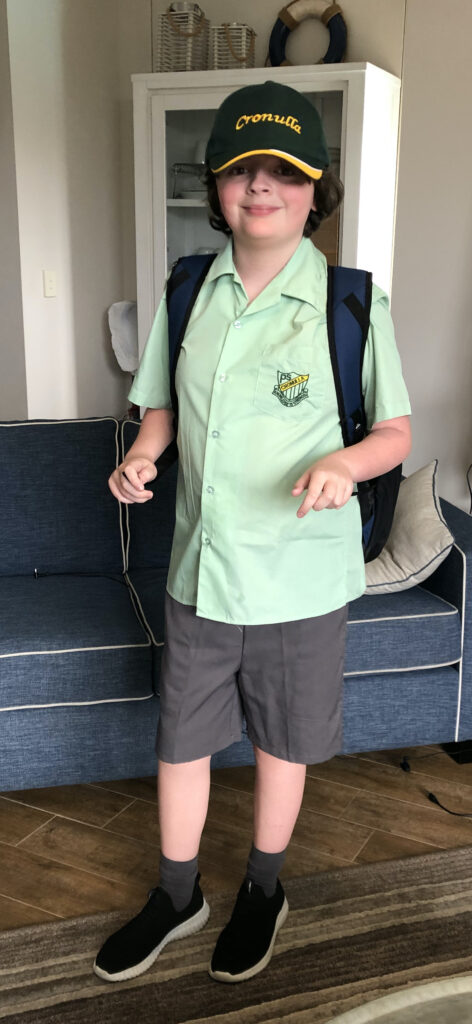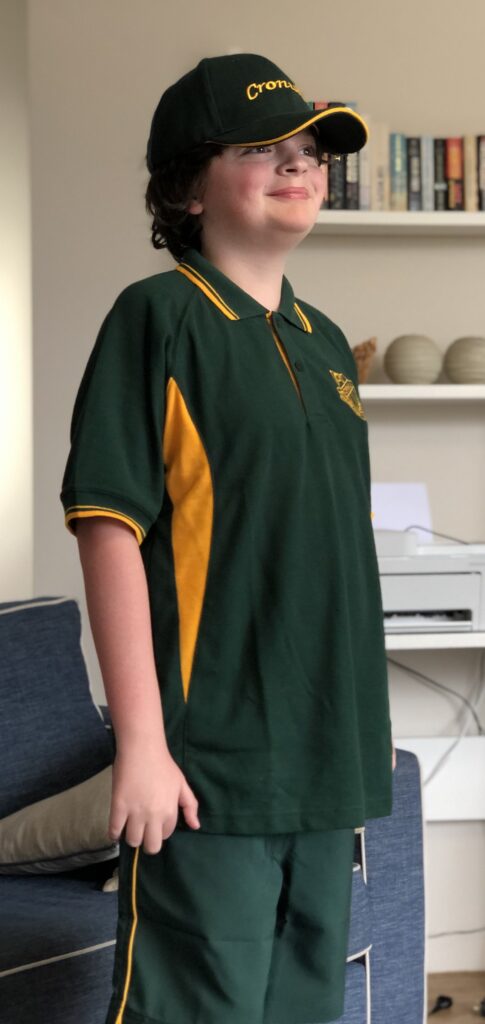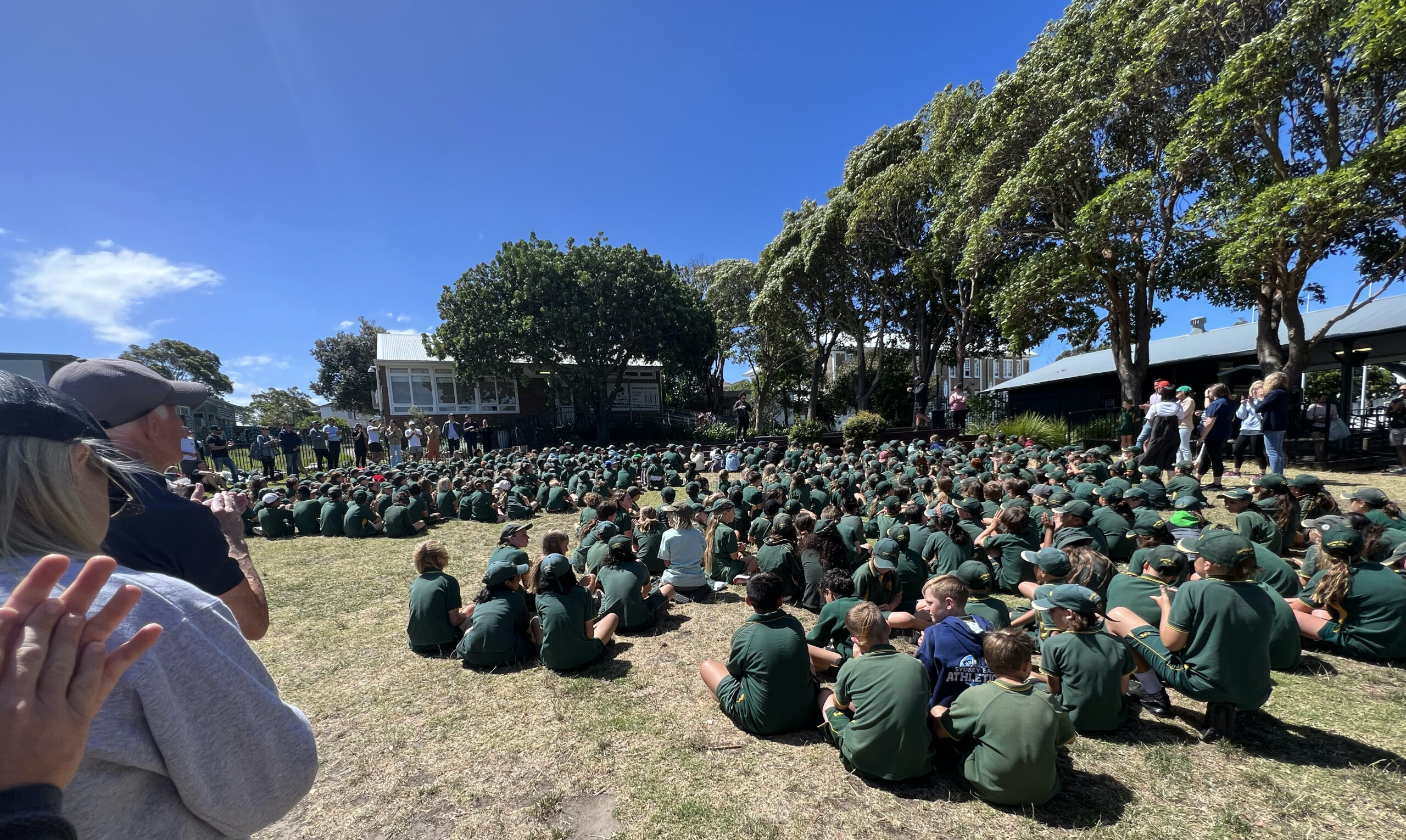All schools in Australia, public and private, require students to wear uniforms. For boys, this is a collared shirt in white or a light color with the school crest embroidered on the chest, worn with trousers or shorts in the school colors or gray. Socks are white or gray, or white banded with the school colors. There are jackets and jumpers (translation for Americans: sweatshirts, also called Sloppy Joes in Australia – ?!?) for when the weather’s cooler.
Primary school students are required to wear hats outdoors, which may be baseball caps or cricket hats. Primary schools are very strict about this: “No hat, no play.” It’s to get the kids early into the habit of avoiding exposure to Australia’s fierce sun. High school students can buy hats, but getting teenagers to wear them is no longer the teachers’ responsibility.


Primary school girls’ uniforms are simple dresses in a plaid in the school colors with a Peter Pan collar. In some cases this is truly horrendous – Mitchell’s primary school colors were green and gold, so the girls’ dresses were an awful yellow and green plaid. In high school, girls wear white collared blouses with plaid pleated skirts, often extremely short. I suspect that the religious schools have requirements about skirt length, but apparently none exist in public schools. A flock of schoolgirls can look like Humbert Humbert’s wet dream.
Schools do allow for kids to manage their own gender expression, style, and comfort – I occasionally see girls (or they may be non-binary) in uniform trousers.
Two pairs of shoes are required, black leather for normal days and sneakers for sports days. Oh, did I mention sports uniforms? At least one day a week is designated for all students to wear their sports uniforms, generally a polo-style shirt and shorts for all, or lined track pants in cooler weather. Kids may also have to bring their sports clothes to change into for a gym class on an additional day. There are no lockers, so everyone must carry this change of clothing all day, which adds to the already considerable weight of backpacks.
In Year 7 (the first year of high school), Mitchell at least had gym on the same day each week so it was easier to remember when he needed to pack his sports uniform. Now in year 8, the gym day changes in alternate weeks, giving us all one more thing to keep track of.
There are a few special days per year when you don’t wear a uniform: Color Day, when you wear the color of your school house (these are not a big deal — we’re not talking Hogwarts), mufti day when you can wear whatever you like, and Book Week, when (for one day) you are supposed to dress as a character from a book. Predictably, some parents get competitive about elaborate or clever costumes for their primary schoolers. High school kids don’t seem as enthusiastic about it.
Having school uniforms is great in some ways, not so great in others.
The pros:
- There’s never any question what to wear, saving time and hassle in the mornings. (Except for the confusion about whether it’s a day he needs to wear or carry his sports uniform.)
- In the high-conformity environment of school, everyone wearing the same things gives one less attack vector for bullies. Clothing can’t be used as a marker of money or social status.
- If kids are causing problems outside the school in or around school hours, eg at the local mall, it’s easy to spot what school they go to. Complaints go to the school administrators, who have strong feelings about kids representing their schools properly.
- If you’re a teacher leading a field trip, it’s easier to keep track of which students are yours.
The cons:
- The expense – see Lowe’s for pricing. Because no one can do laundry every day, you need multiples of most items, and of course kids are constantly growing. And losing things. The items are fairly durable, but kids are hard on clothing. At least no one seems to care if sports pants are looking ratty by the end of the year. Because kids often grow out of clothing before it even gets to the ratty stage, schools will take in donations of uniforms in good condition to sell at a discount to other students.
- Keeping up with the laundry. Depending how many duplicates you want to buy, you’ll have to wash uniforms at least once a week. In our case there’s extra confusion because Mitchell lives between his mother’s home and ours. Fortunately we live near each other for those last-minute “Oh, he needs a shirt to wear tomorrow” runs.
- Security. If photos of your kid in uniform are posted online, it’s easy for someone to figure out what school they attend and roughly where they live (within a fairly close radius, for primary school). So at the beginning of every school year the police send out messages via the news media reminding proud parents not to post photos of their kids’ first day at school to social media.
For Mitchell, Year 8 has just begun. For the time being, he still fits most of his Year 7 uniforms, but at the rate his feet are growing we would have had to buy shoes anyway!


